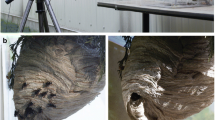Summary
Alarm pheromones, chemical substances produced by social insects to alert the colony to threat, are the principal means by which colony defence is co-ordinated. We present the results of a study on alarm behaviour in 5 swarming species of wasps belonging to the genus Ropalidia. These species show a remarkably efficient strategy of alarm communication, including visual display and attack synchronization. We show that pheromones released from the venom gland play an important role in alarm recruitment in species belonging to the Ropalidia flavopicta group, but not in Ropalidia sumatrae. We analysed the contents of the venom reservoirs content of four of the studied species by gas chromatography-mass spectrometry. Glands were found to contain a complex mixture of volatile compounds as well as spiroacetals of higher molecular weight. Interestingly, despite all species producing similar chemical compounds from the venom gland, these were found to elicit alarm behaviour in only those species that build nest envelopes, suggesting a link between chemical release of alarm behaviour and the evolution of nest architecture in Ropalidia wasps.
Similar content being viewed by others
Author information
Authors and Affiliations
Corresponding author
Additional information
Received 19 August 2003; revised 29 February 2004; accepted 10 March 2004
Rights and permissions
About this article
Cite this article
Fortunato, A., Dani, F.R., Sledge, M.F. et al. Alarm communication in Ropalidia social wasps. Insect. Soc. 51, 299–305 (2004). https://doi.org/10.1007/s00040-004-0744-2
Issue Date:
DOI: https://doi.org/10.1007/s00040-004-0744-2




